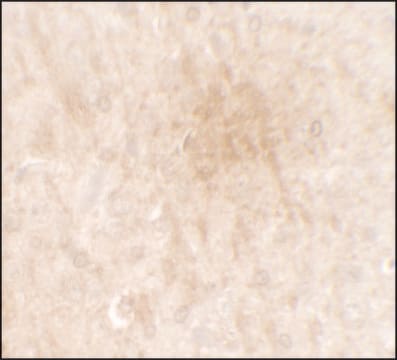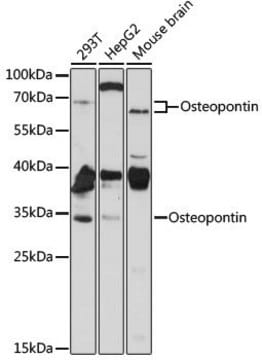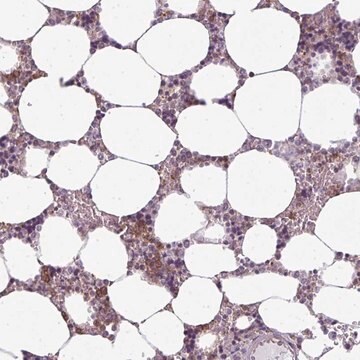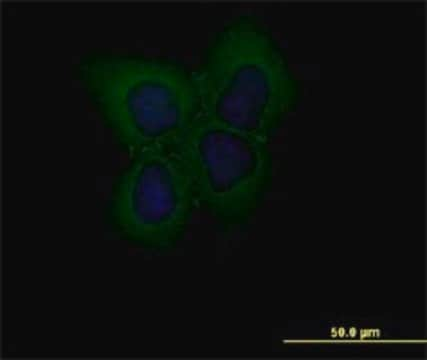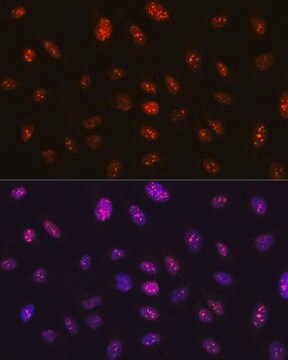推荐产品
生物源
mouse
品質等級
抗體表格
purified antibody
抗體產品種類
primary antibodies
無性繁殖
9E9.1, monoclonal
物種活性
human
包裝
antibody small pack of 25 μg
技術
immunohistochemistry: suitable (paraffin)
western blot: suitable
同型
IgG1κ
NCBI登錄號
UniProt登錄號
運輸包裝
ambient
目標翻譯後修改
unmodified
基因資訊
human ... PTPN2(5771)
相关类别
一般說明
Tyrosine-protein phosphatase non-receptor type 2 (UniProt: P17706; also known as EC: 3.1.3.48, T-cell protein-tyrosine phosphatase, TCPTP) is encoded by the PTPN2 (also known as PTPT) gene (Gene ID: 5771) in human. TCPTP is a non-receptor type tyrosine-specific phosphatase that dephosphorylates a variety of receptor protein tyrosine kinases. It is also reported to dephosphorylate non-receptor tyrosine kinases, such as JAK 1, 2, 3, Src kinases, STAT1, 3, 5, 5B, and 6. TCPTP is ubiquitously expressed and two isoforms have been reported. Isoform 1 is expressed in T-cells and in placenta and is targeted to the endoplasmic reticulum by its C-terminal hydrophobic region. Isoform 2 is reported to be the major isoform that predominantly localizes to chromatin and is able to shuttle between the nucleus and the cytoplasm and to plasma membrane to dephosphorylate receptors. It doing so it negatively regulates numerous signaling pathways and biological processes, including hematopoiesis, inflammatory response, cell proliferation and differentiation, and glucose homeostasis. It is also reported to play a multifaceted and important role in the development of the immune system. In T-cell receptor signaling, it functions through dephosphorylation of FYN and LCK to control T-cell differentiation and activation. It also dephosphorylates CSF1R and thereby negatively regulates its downstream signaling and macrophage differentiation.
特異性
Clone 9E9.1 detects human T-cell protein-tyrosine phosphatase. It targets an epitope within 79 amino acids from the C-terminal half.
免疫原
GST/His-tagged recombinant fragment corresponding to 79 amino acids from the C-terminal half of human T-cell protein-tyrosine phosphatase.
應用
Anti-TC PTPase (PTPN2), clone 9E9.1, Cat. No. MABS1753, is a mouse monoclonal antibody that detects T-cell protein-tyrosine phosphatase and has been tested for use in Immunohistochemistry (Paraffin) and Western Blotting.
Immunohistochemistry Analysis: A 1:50 dilution from a representative lot detected TC PTPase (PTPN2) in human liver, human tonsil, and human cervical cancer tissues.
Western Blotting Analysis: 0.5 µg/mL from a representative lot detected TC PTPase (PTPN2) in 10 µg of Jurkat cell lysate.
Western Blotting Analysis: 0.5 µg/mL from a representative lot detected TC PTPase (PTPN2) in 10 µg of Jurkat cell lysate.
Research Category
Signaling
Signaling
品質
Evaluated by Western Blotting in K562 cell lysate.
Western Blotting Analysis: 0.5 µg/mL of this antibody detected TC PTPase (PTPN2) in 10 µg of K562 cell lysate.
Western Blotting Analysis: 0.5 µg/mL of this antibody detected TC PTPase (PTPN2) in 10 µg of K562 cell lysate.
標靶描述
~48 KDa observed; 48.47 kDa calculated. Uncharacterized bands may be observed in some lysate(s).
外觀
Protein G purified
Format: Purified
Purified mouse monoclonal antibody IgG1 in buffer containing 0.1 M Tris-Glycine (pH 7.4), 150 mM NaCl with 0.05% sodium azide.
儲存和穩定性
Stable for 1 year at 2-8°C from date of receipt.
其他說明
Concentration: Please refer to lot specific datasheet.
免責聲明
Unless otherwise stated in our catalog or other company documentation accompanying the product(s), our products are intended for research use only and are not to be used for any other purpose, which includes but is not limited to, unauthorized commercial uses, in vitro diagnostic uses, ex vivo or in vivo therapeutic uses or any type of consumption or application to humans or animals.
Not finding the right product?
Try our 产品选型工具.
儲存類別代碼
12 - Non Combustible Liquids
水污染物質分類(WGK)
WGK 1
Ying Cheng et al.
Nature neuroscience, 21(12), 1689-1703 (2018-11-07)
Genetic analyses have linked microRNA-137 (MIR137) to neuropsychiatric disorders, including schizophrenia and autism spectrum disorder. miR-137 plays important roles in neurogenesis and neuronal maturation, but the impact of miR-137 loss-of-function in vivo remains unclear. Here we show the complete loss
我们的科学家团队拥有各种研究领域经验,包括生命科学、材料科学、化学合成、色谱、分析及许多其他领域.
联系技术服务部门